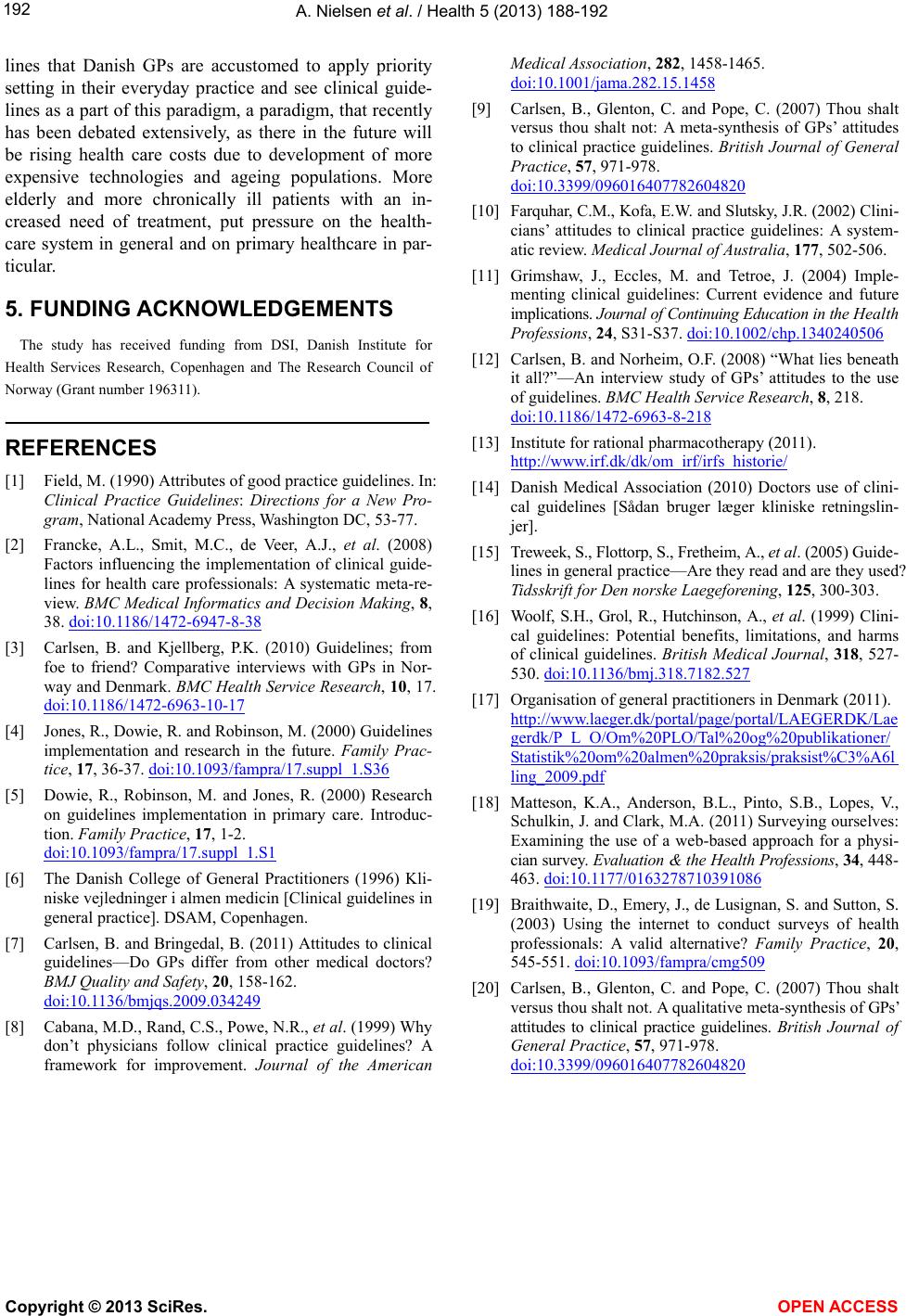
A. Nielsen et al. / Health 5 (2013) 188-192
Copyright © 2013 SciRes.
192
lines that Danish GPs are accustomed to apply priority
setting in their everyday practice and see clinical guide-
lines as a part of this paradigm, a paradigm, that recently
has been debated extensively, as there in the future will
be rising health care costs due to development of more
expensive technologies and ageing populations. More
elderly and more chronically ill patients with an in-
creased need of treatment, put pressure on the health-
care system in general and on primary healthcare in par-
ticular.
OPEN ACCESS
5. FUNDING ACKNOWLEDGE MENTS
The study has received funding from DSI, Danish Institute for
Health Services Research, Copenhagen and The Research Council of
Norway (Grant number 196311).
REFERENCES
[1] Field, M. (1990) Attributes of good practice guidelines. In:
Clinical Practice Guidelines: Directions for a New Pro-
gram, National Academy Press, Washington DC, 53-77.
[2] Francke, A.L., Smit, M.C., de Veer, A.J., et al. (2008)
Factors influencing the implementation of clinical guide-
lines for health care professionals: A systematic meta-re-
view. BMC Medical Informatics and Decision Making, 8,
38. doi:10.1186/1472-6947-8-38
[3] Carlsen, B. and Kjellberg, P.K. (2010) Guidelines; from
foe to friend? Comparative interviews with GPs in Nor-
way and Denmark. BMC Health Service Research, 10, 17.
doi:10.1186/1472-6963-10-17
[4] Jones, R., Dowie, R. and Robinson, M. (2000) Guidelines
implementation and research in the future. Family Prac-
tice, 17, 36-37. doi:10.1093/fampra/17.suppl_1.S36
[5] Dowie, R., Robinson, M. and Jones, R. (2000) Research
on guidelines implementation in primary care. Introduc-
tion. Family Practi ce , 17, 1-2.
doi:10.1093/fampra/17.suppl_1.S1
[6] The Danish College of General Practitioners (1996) Kli-
niske vejledninger i almen medicin [Clinical guidelines in
general practice]. DSAM, Copenhagen.
[7] Carlsen, B. and Bringedal, B. (2011) Attitudes to clinical
guidelines—Do GPs differ from other medical doctors?
BMJ Quality and Safety, 20, 158-162.
doi:10.1136/bmjqs.2009.034249
[8] Cabana, M.D., Rand, C.S., Powe, N.R., et al. (1999) Why
don’t physicians follow clinical practice guidelines? A
framework for improvement. Journal of the American
Medical Associa tion, 282, 1458-1465.
doi:10.1001/jama.282.15.1458
[9] Carlsen, B., Glenton, C. and Pope, C. (2007) Thou shalt
versus thou shalt not: A meta-synthesis of GPs’ attitudes
to clinical practice guidelines. British Journal of General
Practice, 57, 971-978.
doi:10.3399/096016407782604820
[10] Farquhar, C.M., Kofa, E.W. and Slutsky, J.R. (2002) Clini-
cians’ attitudes to clinical practice guidelines: A system-
atic review. Medical Journal of Australia, 177, 502-506.
[11] Grimshaw, J., Eccles, M. and Tetroe, J. (2004) Imple-
menting clinical guidelines: Current evidence and future
implications. Journal of Cont inuing Educati on in the H e a l t h
Professions, 24, S31-S37. doi:10.1002/chp.1340240506
[12] Carlsen, B. and Norheim, O.F. (2008) “What lies beneath
it all?”—An interview study of GPs’ attitudes to the use
of guidelines. BMC Health Service Research, 8, 218.
doi:10.1186/1472-6963-8-218
[13] Institute for rational pharmacotherapy (2011).
http://www.irf.dk/dk/om_irf/irfs_historie/
[14] Danish Medical Association (2010) Doctors use of clini-
cal guidelines [Sådan bruger læger kliniske retningslin-
jer].
[15] Treweek, S., Flottorp, S., Fretheim, A., et al. (2005) Guide-
lines in general practice—Are they read and are they used?
Tidsskrift for Den norske Laegeforening, 125, 300-303.
[16] Woolf, S.H., Grol, R., Hutchinson, A., et al. (1999) Clini-
cal guidelines: Potential benefits, limitations, and harms
of clinical guidelines. British Medical Journal, 318, 527-
530. doi:10.1136/bmj.318.7182.527
[17] Organisation of general practitioners in Denmark (2011).
http://www.laeger.dk/portal/page/portal/LAEGERDK/Lae
gerdk/P_L_O/Om%20PLO/Tal%20og%20publikationer/
Statistik%20om%20almen%20praksis/praksist%C3%A6l
ling_2009.pdf
[18] Matteson, K.A., Anderson, B.L., Pinto, S.B., Lopes, V.,
Schulkin, J. and Clark, M.A. (2011) Surveying ourselves:
Examining the use of a web-based approach for a physi-
cian survey. Evaluation & the Health Profession s, 34, 448-
463. doi:10.1177/0163278710391086
[19] Braithwaite, D., Emery, J., de Lusignan, S. and Sutton, S.
(2003) Using the internet to conduct surveys of health
professionals: A valid alternative? Family Practice, 20,
545-551. doi:10.1093/fampra/cmg509
[20] Carlsen, B., Glenton, C. and Pope, C. (2007) Thou shalt
versus thou shalt not. A qualitative meta-synthesis of GPs’
attitudes to clinical practice guidelines. British Journal of
General Practice, 57, 971-978.
doi:10.3399/096016407782604820